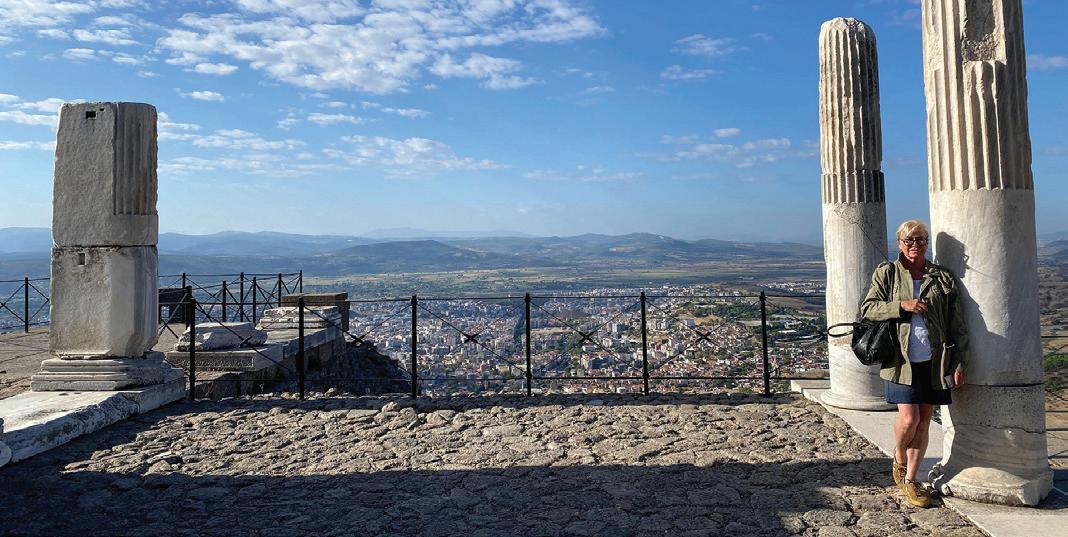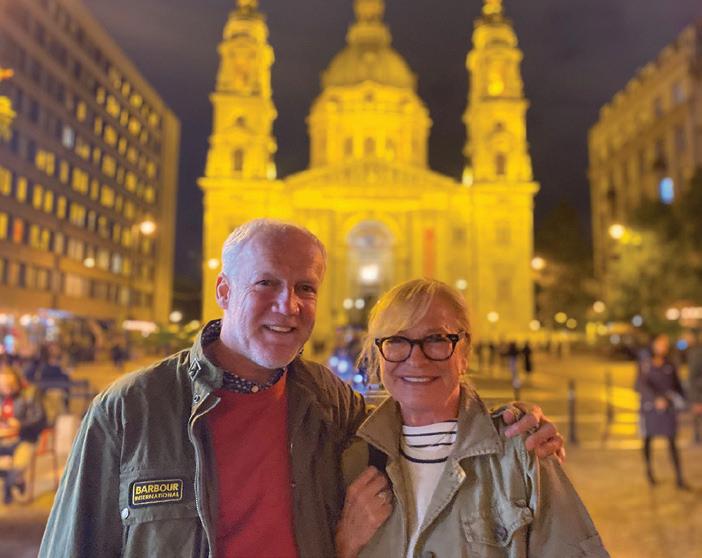
7 minute read
In Patrick Leigh Fermor’s
Travel
In Paddy’s footsteps
Advertisement
Justin Marozzi tracked his hero, Patrick Leigh Fermor, from Istanbul to Nazi Austria – in a 1956 Bristol

Justin’s Bristol, aka Frieda – with FRD 405 numberplate – on the dock at Igoumenitsa, Greece, with other Bristols
Iwonder what Paddy Leigh Fermor would have made of it.
The doyen of travel writers, a dedicated pedestrian who trudged flood damage. And I’ve liked every Turk I’ve ever met.’ But, then again, even if Turkey was never really his thing, perhaps he would and long-time owners of 10 DPG, a Bristol 405 drophead which is surely the best-travelled Bristol on the planet. What could possibly go wrong? The across Europe from the Hook of Holland to Constantinople and always embraced St Augustine’s creed of solvitur ambulando – it is solved by walking – might not have had much truck with a 6,000-mile classic car tour to the remoter regions of Turkey.
Here was a Hellenophile for whom Constantinople – never Istanbul – was his true north. Visiting him at his home in the Peloponnese in 2007, I asked him whether he shared the Greek regret at the loss of Constantinople to the Ottomans in 1453.
‘Only in a romantic sense,’ he replied. ‘You can’t just forget 2,500 years of history and call it Istanbul. I deplore the Turkish role in Eastern Europe, but of course you can’t blame them. It would be like blaming the laws of hydrostatics for have been tickled by the idea of a madcap motor across the continent and far beyond in his honour – and partly in his footsteps. If the sun-parched days of driving were not to his liking, the long, bibulous evenings in the hotels, bars and restaurants of Europe and Turkey would surely have been right up his strasse. And so it was that, earlier this autumn, eight Bristols, mostly from the 1950s, and one Bristol-engined AC Greyhound (immediately nicknamed the AC Grayling by my wife and chief navigator), set out on the road to Istanbul and our Ultima Thule – Gaziantep on the Syrian border. The journey was the brainchild of Geoffrey and Hilary Herdman, Leigh Fermor fans, intrepid travellers answer was everything – and ultimately nothing. What is an adventure without the possibility of ruin? We could have attempted this journey in a modern VW Golf – but what would have been the point? Bristols are superb, hand-built cars, beautifully put together by highly skilled aeronautical engineers retained after the war. Their cooling systems, however, are of their time. In my 13 years of ownership, Frieda – my 1956 405 – has often had to pull over onto the hard shoulder, or be pushed off the road altogether. Onwards to Istanbul, a frantic flash down French, Italian and Greek motorways. Where Paddy trudged, we charged. He might have managed 20 to 30 miles a day. We had to knock off 200,
300 and, a couple of times, more than 400, in a blur of high-speed, high-decibel motoring under a persistent threat of overheating and breakdown. The footloose, footsore, 18-year-old Paddy took a blissful, life-changing 13 months to reach Istanbul. We took five days.
Onwards again towards Eskişehir, and Byzantine Dorylaeum, then south-east to Göreme, in the heart of Cappadocia – a world of fairy chimneys, cave hotels and seething tourist crowds.
We hammered the roads by day and, in homage to Paddy, the wine by night. Days of grey, molten ribbons pasted across a sun-frazzled landscape. Days on tenterhooks, as we watched the oil and water temperature gauges rise pitilessly towards motoring nemesis. Neckshattering days climbing steep Turkish passes, dreading the encounter with a slow-moving juggernaut which would force us into first gear, overheating, loss of power and breakdown.
Sometimes, as at Gaziantep, we managed some cultural sightseeing, immersing ourselves in the glorious Zeugma Mosaic Museum, the world’s largest.
At other times, technical challenges – our only fan packing up at 37°C, for instance – meant that stopping off to see the sublime Roman theatre at Aspendos on the Antalya coast was not an option.
On to Bodrum, ancient Halicarnassus, where we paid our respects to the home-town boy Herodotus, before whizzing north to Ephesus, Pergamon and Troy. Now we were homeward bound.
Mani and Roumeli, Paddy’s books on southern and northern Greece respectively, were hailed by the FT as ‘two of the best travel books of the century’.
In the latter, he wrote admiringly of the Cretan quality of leventeia: ‘It is universal zest for life, the love of living dangerously and a readiness for anything.’
These words rang in our ears as we tore across Europe’s motorways at up to 80mph, steering wheel shaking disconcertingly, slightly regretting Frieda’s lack of seat belts and wing mirrors.
In The Broken Road, the posthumously published final volume in Paddy’s Great Trudge trilogy, he wrote of Bulgarians as a ‘rough-hewn and tough’ people. The description does justice to their abominable pot-holed roads, too.
After blasting through Bulgaria in a chassis-testing frenzy, we hurtled through Romania in a day.
Paddy sashayed across it in months, throwing himself into high-society Bucharest – not to mention the female population of the countryside – con brio, with ‘the zest of a barbarian padding wild-eyed with longing for luxury and corruption through the palaces and fountained courtyards of Diocletian, or of a Parthian in Antioch’.
In Sibiu, former capital of enchanted Transylvania, we made our pedestrian pilgrimage to the august Imparatul Romanilor Hotel, where Paddy is said to have stayed. Disinterring fact from fiction in his travel writing is never easy and probably inadvisable. Best to enjoy the prose and not worry about the details.
We roared on north-west, Frieda in fine form now in cooler climes.
Almost a century earlier, Paddy’s fortunes had also taken a turn for the better on his arrival in the Hungarian capital after a night or two sleeping rough – and dew-sodden – with swineherds.
‘When a mid-morning sunbeam prised one eyelid open a few days later, I couldn’t think where I was. An aroma of coffee and croissants was afloat under a vaulted ceiling; furniture gleamed with beeswax and elbow-grease; books ascended in hundreds, and across the arms of a chair embroidered with a blue rampant lion with a forked tail and a scarlet tongue, a dinner jacket was untidily thrown… Then, suddenly, illumination came. I was in Budapest.’
So were we, for an evening. While Paddy had been ‘back among barons’, ligging his way around the city in black-tie splendour, we lorded it up in the Budapest Hilton, perched high in Buda alongside the 18th-century castle.
My cousin, who has lived here for 20 years, took us to Café Kör, a homespun restaurant, where we did all we could with a barrage of Hungarian rosé.
The evening reminded me of Paddy’s lifelong fondness for retsina: ‘One of its secrets is drinking it with unstinted abundance. It seems to have an alliance with the air in the promotion of wellbeing. Many people think that it bestows the gift of bodily health as well; a belief I accept at once without further scrutiny.’
In Austria, an unexpected Nazi interlude. Paddy crossed Europe in the winter of 1933/4, several years before the war, but early enough to detect – in Munich’s Hofbräuhaus, seething with beer-swilling, Jew-hating Storm Trooper Brownshirts – impending violence (he was also writing up his travels decades later). We diverted to Mauthausen, one of the most notorious concentration camps, to witness some of the legacy of that savagery. At least 90,000 were killed behind these high walls.
In Heidelberg, all roads led inevitably to Zum Roten Ochsen (the Red Ox), the city’s most venerable inn, still owned by the same family who welcomed the shivering Paddy through its doors, into ‘an entrancing haven of oak beams and carving and alcoves and changing floor levels’ in the last days of 1933.
‘This was the moment I longed for every day. Settling at a heavy inn-table, thawing and tingling, with wine, bread, and cheese handy and my papers, books and diary all laid out; writing up the day’s doings, hunting for words in the dictionary, drawing, struggling with verses, or merely subsiding in a vacuous and contented trance while the snow thawed off my boots.’
A couple of days later, heads still reverberating with Frieda’s six-cylinder boom, we returned home to Walsingham, a place of pilgrimage for a thousand years, our adventure over.
Paddy Leigh Fermor, and Bristol motor cars, we salute you.

Left: Julia Marozzi at the Greek ruins of Pergamon, Turkey
Below: Justin and Julia in Budapest

Justin Marozzi is author of The Man Who Invented History: Travels with Herodotus (John Murray)










